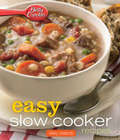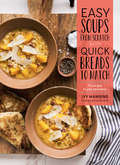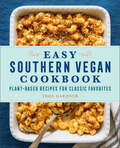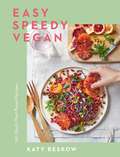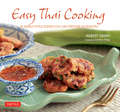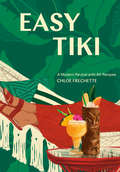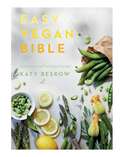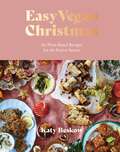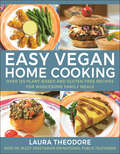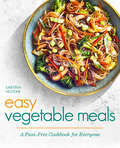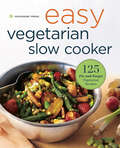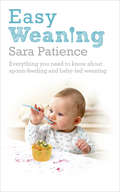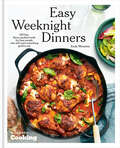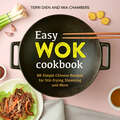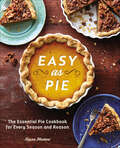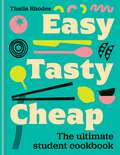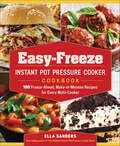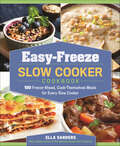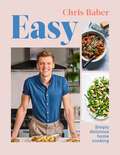- Table View
- List View
Easy Slow Cooker Recipes: Wiley Selects (Betty Crocker Cooking)
by Betty CrockerSimple, scrumptious slow cooker meals are a cinch with this cookbook from Betty Crocker.A slow cooker makes it easy to get family meals on the table fast—just get everything started before you leave for the day, then come home to a fully cooked dinner! Inside, you'll find a quick guide to understanding your slow cooker, plus over 20 proven slow cooker recipes for comforting soups, stews and main dishes, including zesty international options and healthy vegetarian choices.For more great ideas visit bettycrocker.com
Easy Soups from Scratch with Quick Breads to Match: 70 Recipes to Pair and Share
by Ivy Manning Dina AvilaNothing is more comforting at the end of the day than a hearty bowl of homemade soup accompanied by freshly baked bread, and this book shows home cooks how to do it in under an hour. Easy Soups from Scratch with Quick Breads to Match makes it simple to create delicious, nourishing soups and warm, toothsome breads for any day of the week with straight-forward, time-saving recipes. With 70 soups and breads to mix and match, soup lovers can choose from cozy classics like Farro Minestrone with Roasted Garlic Focaccia or international flavors like Barbecue Pork and Miso Ramen with Flaky Green Onion Pancakes. Readers can rely on helpful troubleshooting tricks and get-ahead tips to make these winning combinations come out perfect every time.
Easy Southern Vegan Cookbook: Plant-Based Recipes for Classic Favorites
by Troy GardnerSatisfy your cravings with vegan Southern classics Great news! You can eat vegan and still enjoy all the beloved, belly-warming flavors of Southern comfort food. This cookbook shows you how, walking you through the ingredients and techniques you need to serve up plant-based versions of everything from jambalaya to peach cobbler.Start with the staples—Get a crash course in vegan cooking, and learn how to re-create the signature flavors of buttermilk, mayonnaise, andouille, and more with plant-based foods.Simple cooking methods—Save time and hassle with 75 recipes that only require a handful of basic ingredients—many of them can even be made in 30 minutes, in one pot, or prepared ahead of time.Familiar flavors—Dig into Vegan Chicken Gumbo, Four-Bean Chili, Creamy Cajun Pasta, Jackfruit Barbacoa Tacos, Beer-Battered Okra, Bourbon Pecan Pie, and more.Build a healthier Southern kitchen today with the Easy Southern Vegan Cookbook.
Easy Spanish Cookbook: Recipes to Bring Home the Flavors of Spain
by Norema SalinasBring the flavors of Spain home—delicious dishes that anyone can makeYou don't have to live in Spain to recreate its savory delicacies in your very own kitchen. The Easy Spanish Cookbook helps chefs of all skill levels serve up a flavorful variety of classic Spanish dishes.Covering everything from tapas, pintxos, and other small plates to rice, meat, and seafood entrees, this beginner-friendly Spanish cookbook sets you up for long-term culinary success. Learn how to stock a kitchen perfect for preparing Spanish food—no shopping at specialty grocers required. This Spanish cookbook is even filled with tips to help you integrate more traditional ingredients and create regional variations.The Easy Spanish Cookbook includes:60 Spanish favorites—Delight friends and family with iconic Spanish delicacies, including Mixed Paella, Bay Scallop Pie, and Catalonian Fish Stew.Regional overviews—Journey from Catalonia to Galicia with a Spanish cookbook that takes you across the whole of Spain.Easy-to-find ingredients—Enjoy recipes that deliver authentic flavors without relying on hard-to-find specialty ingredients.Start on the road to mastering Spanish cuisine with this Spanish cookbook.
Easy Speedy Vegan: 100 Quick Plant-Based Recipes
by Katy Beskow"...this book is a particular godsend to those who have only recently adopted the plant-based life, as well as those who are trying to cut down on meat consumption and boost intake of vegetables generally." - Nigella LawsonSimple, straightforward and delicious – Easy Speedy Vegan is the ultimate guide for plant-based mealtimes, bringing you 100 new recipes from bestselling author Katy Beskow. Easy to prepare, quick to cook and using readily available ingredients, this book is not only the go-to cookbook for new and established vegans, but also for home cooks looking for effortless ways to bring plant-based meals into their kitchen. The modern world of vegan cooking can often be confusing, but with a list of easy-to source store-cupboard essentials, useful kitchen equipment, details on common vegan substitutions and demystifying explanations of increasingly popular vegan ingredients (such as jackfruit and silken tofu) you’ll be able to produce delicious food, every time hunger calls. Whether you've got 10, 20 or 30 minutes, there’s something to satisfy at any time of the day, no matter how little time you have. This is feel-good, effortless food by an expert in vegan cooking – and the only plant-based cookbook you’ll ever need.
Easy Thai Cooking
by Corinne Trang Robert DanhiThai cooking has taken the world by storm. Its rich combinations of sweet, sour, salty and spicy flavors makes Thai dining a complete sensory pleasure. Robert Danhi's Easy Thai Cooking features 75 delicious Thai recipes that you can prepare any day of the week.James Beard nominee and CIA trained chef, Robert Danhi gives you expert guidance on acquiring and maintaining a well-stocked Thai pantry. With basic ingredients and his step-by-step instructions you can make stunning dishes like Grilled Chicken Wings with Kaffir Lime Chili Glaze or Sweet-n-Spicy Pork Ribs or Green Mango and Cashew Salad. With the help of Easy Thai Cooking, you can bring the taste of Thailand home!
Easy Thai Cooking
by Corinne Trang Robert DanhiThai cooking has taken the world by storm. Its rich combinations of sweet, sour, salty and spicy flavors makes Thai dining a complete sensory pleasure. Robert Danhi's Easy Thai Cooking features 75 delicious Thai recipes that you can prepare any day of the week.James Beard nominee and CIA trained chef, Robert Danhi gives you expert guidance on acquiring and maintaining a well-stocked Thai pantry. With basic ingredients and his step-by-step instructions you can make stunning dishes like Grilled Chicken Wings with Kaffir Lime Chili Glaze or Sweet-n-Spicy Pork Ribs or Green Mango and Cashew Salad. With the help of Easy Thai Cooking, you can bring the taste of Thailand home!
Easy Tiki: A Modern Revival with 60 Recipes
by Chloe Frechette60 recipes inspired by the history of tiki as well as the modern revival that's putting a fresh spin on tropical tiki drinks--all simplified for the home bartender from cocktail authority PUNCH.Tiki is the dream of escape, a tropical vacation complete with warm ocean water, island music, and beachside dinners. Kicking back with a tiki cocktail may be the epitome of easy living, but ironically, tiki drinks are among the hardest to make, often requiring eight or more ingredients. Now Easy Tiki is here to solve that problem! Easy Tiki examines the modern tiki revival offering sixty transporting recipes that re-jigger the classics with minimal ingredients while still maintaining the delicious balance, spices, and stunning garnishes that define tiki cocktails. Drinks include classics such as the Beachcomber's Gold and Fog Cutter and modern cocktails such as Elusive Dreams and Paradise Lost. Easy Tiki also includes an overview of the origins of the tiki genre, from Don the Beachcomber and the mid-century tiki craze to Trader Vic's and beyond. With Easy Tiki it's easier than ever before to sit back with a Mai Tai or Pearl Diver and enjoy the island life--wherever you are.
Easy Vegan Baking: 80 Easy Vegan Recipes - Cookies, Cakes, Pizzas, Breads, and More
by Jerome Eckmeier Daniela LaisGet ready for scrumptious, sweet and savory vegan treats that just about everyone can eat! This is your foolproof guide to decadent, delicious, and dairy-free vegan baking. From cakes and muffins to pizza and bread, bake up all your favorite dishes without using eggs, milk, or butter. Inside the pages of this plant-based baking book, you&’ll discover: • Over 80 recipes for vegan baked goods that you'll love to eat and be proud to serve. • Easy-to-source and inexpensive ingredients that can be found in your local supermarket. • Straightforward techniques, easy-to-follow instructions and vegan baking tips. From raspberry cake to spinach quiche and spicy muffins, transform your plant-based diet with guilt-free vegan recipes that ooze, crunch, crumble and melt just like their originals. Whether you&’re vegetarian, vegan or suffering from intolerances, this vegan baking book serves up dishes sure to hit your sweet spot or savory craving! Vegan Cakes and Other Bakes proves that you don&’t need animal-based ingredients to create baking wonders. It&’s packed with vegan cooking advice on how you can easily make plant-based alternatives to butter, cream and eggs. Every recipe has a stunning photo of the finished bake, giving you the inspiration you need to start baking vegan snacks, mains and desserts!
Easy Vegan Bible: 200 Easiest Ever Plant-based Recipes
by Katy BeskowSimple, straightforward and delicious – Easy Vegan Bible is the ultimate guide for plant-based mealtimes, bringing you 200 new recipes from bestselling author Katy Beskow.Easy to prepare, quick to cook and using readily available ingredients, this book is not only the go-to cookbook for new and established vegans, but also for home cooks looking for effortless ways to bring plant-based meals into their kitchen. The modern world of vegan cooking can often be confusing, but with a list of easy-to source store-cupboard essentials, useful kitchen equipment, details on common vegan substitutions and demystifying explanations of increasingly popular vegan ingredients (such as jackfruit and silken tofu) you’ll be able to produce delicious food, every time hunger calls.Clearly labelled as 15-minute, 30-minute, 5-ingredient or one-pot, the recipes cater for every craving. From French toast for breakfast or a Chickpea and pesto toastie for lunch, to suppertime Panzanella or Katy’s vibrant Spring risotto, every mealtime is covered. There are even recipes for those special occasions, like Christmas chestnut cassoulet, a heady Summer punch for those long warm evenings, and satisfying sweet treats such as Rhubarb and orange crumble or Sticky toffee flapjack. This is feel-good, effortless food by an expert in vegan cooking – and the only plant-based cookbook you’ll ever need.
Easy Vegan Christmas: 80 Plant-Based Recipes for the Festive Season
by Katy BeskowEasy Vegan Christmas is a 80-recipe cookbook showcasing simple vegan recipes, for a fuss-free festive season. Whether you’re cooking for your vegan family, looking for inspiration for your first vegan guest, or simply want to add new flavours and dishes to your Christmas dinner table, you’ll find stress-free, plant-based recipes to get you through the happy holidays. With an easy tip for each recipe, plus advice on whether the recipe is suitable for freezing, this book is perfect for getting ahead! You’ll also find a handy menu planner to take the stress out of deciding what to cook. All of the ingredients are available in supermarkets, with a focus on seasonal winter produce. The magic of Christmas is in togetherness and giving, and there’s nothing that shows this more than a special, hearty meal, prepared with love.
Easy Vegan Comfort Food: 80 Favorites Made Vegan in 5 Steps or Less
by Barb MusickTransform your favorite comfort foods into delicious vegan delights Plant-based eating doesn't mean you have to settle for a life without comfort food! Easy Vegan Comfort Food is an enticing entry into vegan cookbooks, with 80 recipes for comfort food classics that can be made in 5 steps or less. Start with an overview of must-have equipment and pantry staples, and learn insider tips and shortcuts to minimize time spent in the kitchen. Then, jump into simple vegan recipes that rely on healthy, whole foods you can easily find at your local grocery store. A standout among vegan cookbooks, Easy Vegan Comfort Food includes: 10-Ingredient recipes—Make it quick and effortless to whip up comfort food favorites with uncomplicated recipes that use 10 familiar ingredients or fewer. Vegan fridge staples—Unlike other vegan cookbooks, this one teaches you how to create veganized essentials like butter, milk, mayonnaise, and more. Recipe hacks—Find suggestions for making recipes ahead of time, swapping or adding ingredients to switch up the flavors, and adapting dishes to accommodate dietary restrictions and preferences. When it comes to vegan cookbooks that make it simple to re-create the comfort foods you know and love, Easy Vegan Comfort Food has you covered.
Easy Vegan Home Cooking: Over 125 Plant-Based and Gluten-Free Recipes for Wholesome Family Meals
by Laura TheodoreFamily friendly, plant-based and gluten-free recipes from PBS Celebrity Chef Laura Theodore.Whether you are an accomplished vegan chef or just learning the craft of creating pleasing plant-based meals for your family, it is essential to find recipes that are delicious and easy to prepare. Celebrity chef Laura Theodore shows you how in Easy Vegan Home Cooking. Featuring healthy recipes that require eight ingredients or fewer and focusing on bountiful breakfasts, light lunches, satisfying suppers, and delightful desserts, Easy Vegan Home Cooking is designed to please vegans, vegetarians, and omnivores alike. Easy Vegan Home Cooking takes the guesswork out of eating healthier by sharing shopping lists, pantry &“must-haves,&” quick cooking tips, flavor enhancers, and effective plant-based substitutions.
Easy Vegetable Meals: A Fuss-Free Cookbook for Everyone
by Larissa OlczakHealthy and filling—cooking vegetables has never been easier You already know eating vegetables is good for you, but sometimes it can be hard to figure out how to include more of them in your everyday meals besides just in a side salad or appetizer. Easy Vegetable Meals is the vegetables cookbook that makes it simple, fast, and easy to eat tons of garden greens, feel full, and enjoy your homemade cooking. Whether you have a box of unfamiliar vegetables from a weekly local produce delivery, or you just got home with a bundle from the farmers market, you'll discover exactly how to enjoy whatever you have with this vegetables cookbook. A handy reference guide will help you quickly learn how to prep, cook, and serve all kinds of veggies—including ones you've never seen before. Inside this vegetables cookbook, you'll find: Recipes abound—With 100 creative and delicious recipes inside this vegetables cookbook, you'll always have something that suits your mood for any meal of the day. Calendar cooking—These wholesome vegetable-forward recipes are sorted by season so you can find and enjoy the freshest vegetables no matter the month. Suit yourself—Easily tailor the recipes in this vegetables cookbook to your own dietary preferences with variation tips to make dishes vegetarian, vegan, and more. Find out just how tasty and filling a meal full of veggies can be with this vegetables cookbook.
Easy Vegetarian Slow Cooker Cookbook: 125 Fix-and-Forget Vegetarian Recipes
by Rockridge PressHealthy, Comforting Vegetarian Meals with the Push of a ButtonYou've gone meat-free, thanks to your conscience, your doctor, or maybe even your teenager. Whatever the reason, the big challenge isn't what to cook—it's how to make healthy, hearty vegetarian meals without spending hours in the kitchen. With Easy Vegetarian Slow Cooker Cookbook, you can take back your time while letting your palate travel the world of vegetarian dishes. No time? All meals prep in 15 minutes or less. Chop and go.Hungry for real food? Not a single recipe calls for fake meat products.No animal products? Over 75 of the 125 recipes are vegan.Got restrictions? Dietary labels indicate whether a recipe is gluten-free, soy-free, and/or nut-free.Counting calories—or carbs? Nutritional information is listed with every recipe.Live your life and let Easy Vegetarian Slow Cooker Cookbook toil in the kitchen for you. Recipes include: Coconut Curry Simmer Sauce, Healing Vegetable Soup, Chiles Rellenos with Fresh Mozzarella, Eggplant in Hoisin Garlic Sauce, Banana Nut Bread, and more!
Easy Weaning: Everything you need to know about spoon feeding and baby-led weaning
by Sara PatienceWeaning your child has never been so confusing: the government says one thing, an expert says another; some people are into baby-led weaning, some swear by purées. Easy Weaning cuts through the noise and provides clear, realistic advice drawn from Sara’s work with thousands of families as a health visitor, nutritionist and nurse. Without seeking to promote one weaning method over another, Easy Weaning equips you with all the information you need to confidently wean and feed your child.· Step by step advice for all the key stages of weaning· How to establish healthy eating patterns· Simple, delicious recipes that all the family can enjoy· Detailed chapters on fussy eating, allergies and intolerances, problem-solving and more!
Easy Weeknight Dinners: 100 Fast, Flavor-Packed Meals for Busy People Who Still Want Something Good to Eat [A Cookbook]
by Emily Weinstein New York Times CookingTake the stress out of weeknights with 100 easy, quick, and flavorful recipes from NYT Cooking. It&’s Tuesday, 4 p.m. What&’s for dinner? For busy people who want something good to eat, culinary powerhouse New York Times Cooking makes meal planning easy, with thousands of recipes to explore in the app. In Easy Weeknight Dinners, editor in chief Emily Weinstein has curated some of the greatest hits—100 favorite dishes that you can make in as little as 10 minutes, from trusted writers Melissa Clark, Eric Kim, Yewande Komolafe, Ali Slagle, and more, served with mouth-watering photos and notes from the NYT Cooking community. Organized by main ingredient, length of cooking time, and wow factor, you&’ll find: • Truly fifteen-minute recipes, like Beef Short Rib Rice Bowls• Sheet-pan miracles for easy clean-up, like Feta with Chickpeas and Tomatoes• Minimum effort for maximum magic, like San Francisco-Style Vietnamese American Garlic Noodles• Plate-licking sauces that steal the show, in Shrimp Fried Rice with Yum Yum SauceWhether you&’re seeking a standout meal for one, crowd-pleasers for picky kids, or something special for company, Easy Weeknight Dinners offers versatile, flavor-packed meals for busy lives.
Easy Wok Cookbook: 88 Simple Chinese Recipes for Stir-frying, Steaming and More
by Terri Dien Mia ChambersChinese food in a flash—88 easy, tasty wok recipes that sizzle It's time to toss the takeout menu and start stir-frying like a seasoned master chef. The Easy Wok Cookbook gives you everything you need to get started, including dozens of delicious Chinese dishes, simple instructions, troubleshooting tips and tricks, and more. From flavorful Kung Pao Chicken to crispy Sesame Beef, this authentic Chinese wok cookbook is sure to tantalize your taste buds without breaking your budget—or your patience. Rock your wok with confidence at home with expert tips, including a step-by-step guide to achieving stir-fry success. Welcome to your new Asian-inspired cooking adventure! The Easy Wok Cookbook has it all: 88 Classic and creative recipes—Discover how to stir-fry, steam, and simmer a delectable mix of traditional Chinese foods, American Chinese takeout favorites, and Chinese fusion dishes. Doable dishes—Save time and money with these easy wok cookbook recipes that can be made in under 30 minutes, under $10, or with 5 ingredients or less. Essential extras—Learn what to look for when choosing a new wok, cleaning and seasoning your wok, and what ingredients to keep stocked in your pantry for effortless wok meals any night of the week. Take the guesswork out of what's for dinner and enjoy sizzlin' success with the Easy Wok Cookbook.
Easy as Pie: The Essential Pie Cookbook for Every Season and Reason
by Saura MadaniPie made foolproof—all you knead is loveA warm slice of homemade pie can complete any celebration—but every baker knows that a problematic pie is enough to sour a sweet occasion. This pie cookbook gives you the support you need to start making perfect, homemade pies from scratch.This pie cookbook gets your dough rolling, complete with step-by-step techniques for mixing, shaping, rolling, and finishing your dough. Refine your pastry base with a fail-safe, flaky, buttery crust recipe—or taste the seasons with 50 creative and classic seasonal pies.This pie cookbook includes:Baked to pie-fection—Get advice in this pie cookbook on fundamental tools, common terms, and pantry essentials—as well as troubleshooting for soggy bottoms, cracked custard, and more.Crust you can trust—Achieve the tastiest, flakiest crust with a fail-safe, all-butter recipe, in addition to master recipes for a variety of crusts.Year-round yum—Enjoy a slice of every season with this pie cookbook, including beautiful, delicious pies for spring, summer, fall, and winter, as well as pies suitable for any time of year.Master the art of pie-making and start enjoying a lifetime of fresh, homemade pie with this pie cookbook.
Easy, Tasty, Cheap: The ultimate student cookbook
by AnonymousIf you're heading off to university, starting your first job, or just trying to make ends meet - Easy, Tasty, Cheap is the must-have cookbook for anyone navigating life on a budget. This is the book that every student needs to have in their kitchen and every parent wants their child to take with them as they step into independent living.Whether you're a complete beginner or a budding chef, you'll find over 200 delicious, no-fuss recipes that fit your lifestyle and budget. From simple, satisfying meals for one like Tuna Arrabiata or Cheesy Garlic Bread, to impressive dishes for hosting friends like Minted Lamb Kebabs or Mushroom Stroganoff, Easy, Tasty, Cheap covers every occasion.This cookbook doesn't just teach you how to cook; it also offers practical tips on saving money, stocking your pantry, and making the most out of your weekly shop. With Easy, Tasty, Cheap, you'll gain the confidence to cook tasty, affordable meals that make life easier and more enjoyable.Turn your kitchen into the heart of your home with Easy, Tasty, Cheap - the ultimate guide to eating well while living smart.
Easy, Tasty, Cheap: The ultimate student cookbook
by AnonymousIf you're heading off to university, starting your first job, or just trying to make ends meet - Easy, Tasty, Cheap is the must-have cookbook for anyone navigating life on a budget. This is the book that every student needs to have in their kitchen and every parent wants their child to take with them as they step into independent living.Whether you're a complete beginner or a budding chef, you'll find over 200 delicious, no-fuss recipes that fit your lifestyle and budget. From simple, satisfying meals for one like Tuna Arrabiata or Cheesy Garlic Bread, to impressive dishes for hosting friends like Minted Lamb Kebabs or Mushroom Stroganoff, Easy, Tasty, Cheap covers every occasion.This cookbook doesn't just teach you how to cook; it also offers practical tips on saving money, stocking your pantry, and making the most out of your weekly shop. With Easy, Tasty, Cheap, you'll gain the confidence to cook tasty, affordable meals that make life easier and more enjoyable.Turn your kitchen into the heart of your home with Easy, Tasty, Cheap - the ultimate guide to eating well while living smart.
Easy-Freeze Instant Pot Pressure Cooker Cookbook: 100 Freeze-Ahead, Make-in-Minutes Recipes for Every Multi-Cooker
by Ella SandersDelicious recipes that save time, money, and make meal prep easy!Freezer cooking is a huge time-saver for busy families – you spend one day prepping a month’s worth of meals, to be stored in ziplock bags in the freezer, ready to throw into the Instant Pot, pressure cooker, or multi-cooker for dinner! Rather than slave away every night, you take care of all the planning, shopping, chopping, and measuring in one fell swoop for a month’s worth of delicious meals. And your multi-cooker makes it even easier – just dump, lock, and in a few minutes, dinner’s ready!Instant Pot is a registered trademark of Double Insight Inc. Easy-Freeze Instant Pot Pressure Cooker Cookbook is an independently created book and is not endorsed, sponsored, or authorized by Double Insight Inc.
Easy-Freeze Slow Cooker Cookbook: 100 Freeze-Ahead, Cook-Themselves Meals for Every Slow Cooker
by Ella SandersDinner is done with these 100 easy make-ahead mealsMake dinner a breeze with The Easy-Freeze Slow Cooker Cookbook! Having an incredible meal on the table doesn’t have to be a nightly struggle. These delicious recipes are specially designed for easy preparation so that you can have a month’s worth of meals made in just a couple of hours! The easy-to-follow recipes and tools for organizing your freezer meals will make the question of what’s for dinner a problem of the past. When you’re headed out the door, just pull one of these tasty dinners out of the freezer, toss it in the slow cooker, and come home to that Sunday dinner smell without all of the Sunday dinner effort. With The Easy-Freeze Slow Cooker Cookbook, you can spend less time worrying about how to get dinner on the table, and enjoy more time around it!
Easy. Whole. Vegan.: 100 Flavor-Packed, No-Stress Recipes for Busy Families
by Melissa KingVegan food blogger Melissa King offers 100 simple, healthy, easy to prepare recipes for every meal of the day.Wouldn’t you do more healthy cooking at home—if you only had the time? It can be tough to put dinner on the table without falling back on packaged, processed foods. But for Melissa King, watching her two young daughters struggle with health issues was tougher. She switched her family to a whole foods, plant-based diet—and it made all the difference. Today, Melissa is a master at crafting flavor-packed, no-stress recipes that are Easy. Whole. Vegan. (Plus, they’re gluten-free!) Here are her top 100 meals, snacks, desserts, and more—ingeniously organized by need to help busy families find the right one: QUICK: Make Sweet Potato Pancakes or Avocado & Chickpea Stuffed Cucumbers in 30 minutes or lessEASY: Multitask effortlessly with slow-cooker dishes like Chili Mac & Cheese MAKE-AHEAD: Prep Lentil Shepherd’s Pie when you do have time, and freeze it for later Plus, ENTERTAIN with White Bean & Zucchini Burgers, MAKE IT YUMMY with wholesome condiments like Hidden Veggies Tomato Sauce, and hydrate for health with PICK-ME-UPS like Beet, Orange & Ginger Juice or a Tropical Green Smoothie. You do have time to cook whole, vegan food at home—once a week, or all the time. It’s easy! “Melissa King’s recipes in Easy. Whole. Vegan. are deliciously crafted, easy to prepare, and a delight to dig into. Get ready to experience some healthy, whole foods magic!” —Dreena Burton, author of Plant-Powered Families
Easy: Simply delicious home cooking
by Chris BaberSimple. Speedy. Delicious. Stuffed with quick, simple and mouth-watering recipes, Easy is the only cookbook you'll need to make every meal count without stressing in the kitchen. Whether it's having a crowd of mates over for a weeknight dinner, recreating your favourite takeaway or rustling up a delicious brunch to start the weekend right, Chris has a dish for every occasion. Packed with straightforward recipes - from Spicy Prawn Tostadas and Honey and Harissa Spatchcock Chicken to Veggie Pilaf with Fried Halloumi and Summer Strawberry and Raspberry Crumble - and handy tips, Easy is the perfect guide to creating delicious food that hits the spot every time.
